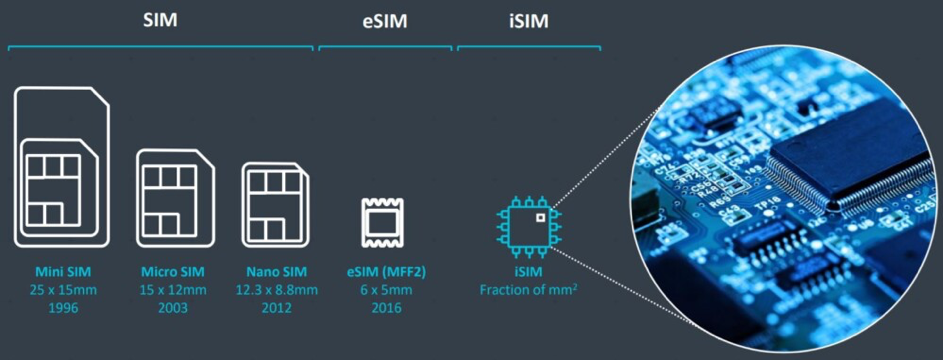Back to articles
The Difference Between SIM, eSIM & iSIM

eSIM and iSIM technologies address the numerous constraints of the physical SIM card, paving the way for new Cellular IoT solutions in the years to come. Here’s what you need to know.
In a recent article on Connectivity For Massive IoT Device Deployments, we touched briefly on embedded SIM (eSIM) technology. An eSIM is smaller, tamper-proof and theft-proof, and can be fully managed remotely, while iSIM technology is set to take things a step further.
Enabling a cellular future
We are racing towards an estimated 20 billion connected devices by 2025. Cellular IoT is set to provide ubiquitous low power connectivity on the back of 4G and 5G networks for IoT applications.
Read more: 2019: The Year of Cellular IoT
Infrastructure providers, network operators, and silicon vendors including Nordic Semiconductor are ready for major Narrowband IoT (NB-IoT) and LTE-M network launches this year, which will help to meet the massive connectivity demand in the years to come.
The constraints of physical SIM cards
Traditional SIM cards are everywhere. Network providers use them to store profiles that authenticate a device, and to provide secure identification and storage. Yet despite their usefulness and their sheer numbers, their design presents problems for a cellular future.
First of all, their size. A physical SIM card occupies a relatively large amount of space in a physical device, especially when you consider its functionality against that of other components. They can easily be damaged and are a problem for theft.
While physical cards still exist in consumer devices such as smartphones, they are far from ideal. From an enterprise perspective, the growing number of SIM-enabled devices presents a maintenance and management headache. Simply put, the need to change SIM cards in millions of IoT devices is just not realistic.

A programmable solution
eSIM technology is a necessary evolution that offers a robust, scalable solution to the SIM card challenge especially for enterprises. It was based on the open, vendor-neutral standard developed by the GSMA.
An eSIM performs a similar role to the traditional SIM card. It controls the authentication and service access for mobile devices, but with one key difference. An eSIM is remotely programmable, typically as an integrated circuit chip soldered permanently into the device.
Improved physical security
eSIM and iSIM have a similar philosophy in taking the chip and its credentials from an insertable card to a device actually physically mounted on the PCB of the product itself. In the case of eSIM it is a chip soldered to the board. iSIM goes a stage further and is integrated into the silicon design of an SoC or MCU in the design.
This means they cannot be physically removed without messy desoldering after which they probably won't work. This means there's more physical anti-tamper/anti-theft protection.
Clearly going from a nano SIM of 12.3mm x 8.8mm to eSIM of 6mm x 5mm saves more than half the space. It's considerably more when you factor in a SIM card has to be located at the edge of a product probably in a specific area for human fingers to access.
The move to iSIM means there is zero space consideration, as it would be an integral part of an already existing device on the board and would represent fractions of a square millimeter of that chip's overall area.
More options for users
eSIM and iSIM are still as configurable as regular SIMs, actually more so. They allow customers to select carriers, data plans, and to change their numbers at will.
Both SIM technologies can be reprogrammed as needed to change carriers and modify restrictions or permissions on your tariff. This also required the development of standards for remote provisioning. Here, SIM information is updated over the cellular network rather than by physically changing a card.
A nice option, especially within mobility IoT such as asset tracking of containers, is that eSIM and iSIM can be used to register a single device on multiple operators, simplifying international roaming. Transfering between carriers won’t require you to replace your SIM. In the future, it should be possible to manage credentials and access multiple devices using eSIM or iSIM using just a single tariff. This applies to both the business and consumer worlds.
The key difference between eSIM vs iSIM is in their implementation. While an eSIM is a dedicated chip attached to a gadget’s processor, an iSIM is embedded in the main SoC alongside the processor. That might only be a subtle difference, but it is an important one for a number of growing use cases that demand high levels of security
The secure iSIM solution
Not yet a standard but widely adopted by industry, iSIM builds on the improvements offered by eSIM technology. The major change is that the SIM hardware is integrated into system-on-chip (SOC) architectures that combine a processor and cellular modem.
While traditional SIM cards offer a level of physical security, both eSIMs and iSIMs are difficult to steal and so improve the integrity of their host device. This is especially true for iSIM. During the design stage, it is physically integrated into the surrounding elements that make up the SoC on the silicon. Also, the additional authentication layer offers root-of-trust for the mobile network operator for payment and other authentication use-cases.
The idea of iSIM options being designed into IoT SoCs is very appealing. From the product development perspective it results in an easier-to-design device at a lower-cost.
For Cellular IoT to truly take off, it must meet the promise of a globally-scalable solution. This means massive numbers of devices at a low cost, so even a small cost saving at the SoC level can make a massive difference at the enterprise level.
This article references an article originally published by ARM Ltd.


